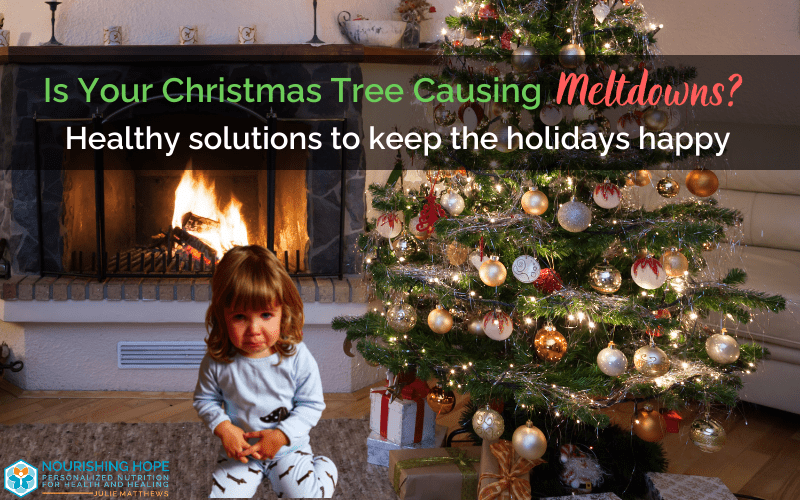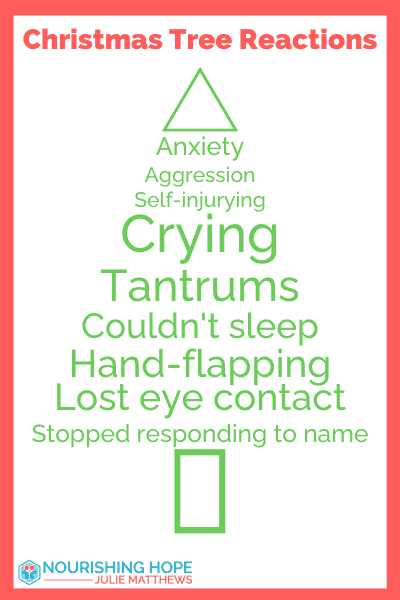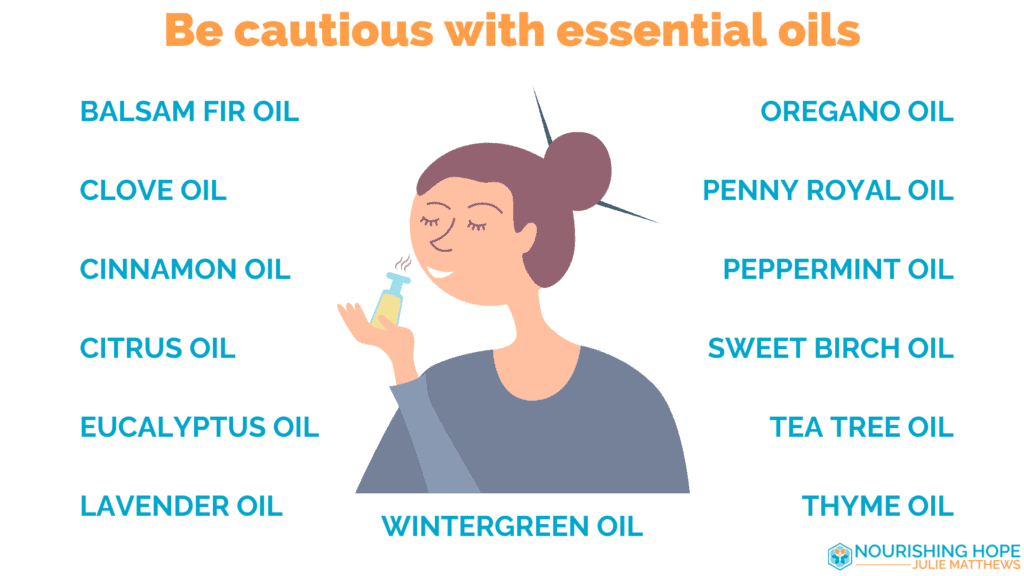
The holidays are a wonderful time for being together with family and celebrating.
But there are also holiday traditions that can inadvertanly lead to behavioral and emotional reactions. Holiday treats and decorations can cause biochemical overload and physiological reactions like hyperactivity, anger, aggression, crying spells, and anxiety. And the things we enjoy as adults, such as: music, lights, and new smells can be overwhelming for a child with sensory sensitivities.
Fortunately understanding them ahead of time can help you plan and adjust as necessary.
Holiday Stressors That Can Cause Meltdowns
- Christmas trees
- Wreaths and pine branches
- Potpourri
- Scented candles
- Perfume
- Lights
- Music
- Strong smelling food
- Food and food additives

Christmas Trees and Wreaths Can Cause Severe Symptoms
 Before you run out and buy a fresh, new Christmas tree or holiday wreath, you’ll want to read about my client’s Christmas tree experience.
Before you run out and buy a fresh, new Christmas tree or holiday wreath, you’ll want to read about my client’s Christmas tree experience.
Her 10 year old son with autism severely regressed during the holidays. After the holidays we had an appointment where I learned about his regression and asked if they had a Christmas tree. Turns out they did and it was the cause of his misery.
Here’s her description:
“During the Holidays our son regressed severely. He became anxious, aggressive, and self-abusive. He cried and had tantrums regularly throughout the day. He couldn’t sleep anymore and was up for hours at a time, night after night. He was hand-flapping like crazy. We have a swing in the house for him and he now wanted to swing all day long, constantly, and do nothing else. He lost eye contact and he stopped responding to his name.
I had made a few minor changes to both his diet and his supplement regimen. When I spoke with Julie Matthews at our nutrition appointment, I explained what was going on and she agreed that these minor changes couldn’t possibly be causing this kind of setback. Julie started asking me questions and going down “the list” of possible culprits. Finally she asked me about our environment. Did we change anything? Buy anything new?
I said ‘no’ but I casually mentioned the Christmas tree, not thinking for a second that it was even relevant. “Christmas tree? Do you guys have a real tree?” Julie asked. Almost immediately, I realized that the timing of our son’s behaviors coincided with the arrival of the Christmas tree and that there was a real possibility that this could be the cause.”
No doubt that the Christmas tree was the culprit, because once it was removed the improvements were dramatic.
The decorations came off and the tree was put out that same night. I didn’t tell anyone at home about our discussion. I wanted to see if they would comment on my son’s behavior after the tree was gone. The next day, he was much calmer. He seemed to have “exhaled.” Within 48 hours, our son was completely back to normal. His improvement was blatantly obvious. And, everyone commented on it.”
Terpenes and Phenols
Christmas trees are varieties of pine trees and as such, they contain terpenes which are highly aromatic compounds that determine the smell of some plants and herbs. Common “scents” that also contain terpenes include rosemary and lavender.
Manufacturers use isolated terpenes to create the flavors and scents of many everyday products, such as perfumes, body products, cleaners, and even foods. In fact, pine-scented cleaners are often derived from 95% terpenes. And for this family, the aromatic oils that give pine trees their great smell were the cause of their child’s behavior, mood, and sleeping issues.
Another compound that can cause issues and that are in some strong smelling oils are phenols. Phenolic compounds come in many forms including artificial petroleum-based food additives, and salicylates found in plants and foods like strawberries and spices, as well as some essential oils such as cinnamon, clove, thyme, and oregano. In the winter, many people (including me!) diffuse these essential oils and blends and/or use soaps that include clove and cinnamon. Or some people simmer water on the stove with cinnamon sticks and clove buds to scent their homes. And to complicate things even more, some varieties of pine trees can also have phenols in addition to terpenes! This time of year can be one in which we are exposed to much higher amounts of phenols.
When phenols are not able to be broken-down and detoxified (by a process called sulfation, which is low in many children with autism and ADHD), they can cause many symptoms including irritability, red cheeks and ears, hyperactivity, aggression toward self and others, “stimming,” sleeping challenges and many more. Terpenes are also processed in a similar biochemical way, further depleting this detoxification pathway and the corresponding nutrients.
If you know your child is sensitive to salicylates, terpenes, or phenols (see my salicylate article), you’ll likely want to avoid a traditional Christmas tree and artificially scented products. If you are unsure about their sensitivity to salicylates: you might ask yourself if your child is often hyper, irritable, or has red cheeks, and other common salicylate symptoms, or whether they crave salicylate-rich foods such as berries, grapes, apples, and ketchup. If so, explore salicylates further.
In fact, since so many children with autism and ADHD react to salicylates (in my nutrition practice I find an overwhelming majority react negatively when consuming or being exposed to too many), I’d suggest a cautious approach to holiday decorating for all families of a child with autism or ADHD. I’ll share some ideas below.
Sadly, there is nothing “fresh” about air fresheners. And while those scented candles and diffusers seem lovely, they also contain these chemicals. Our body needs to detoxify them, and when we can’t do so sufficiently they cause physical and behavioral reactions.
This year skip the scented products.
Even essential oils, which I love, can cause reactions because of the things I’ve described above. Some of the essential oils that may cause reactions include:
 Balsam fir oil
Balsam fir oil- Douglas fir oil
- Siberian fir oil
- Clove oil
- Cinnamon oil
- Citrus oil
- Eucalyptus oil
- Lavender oil
- Oregano oil
- Pennyroyal oil
- Peppermint oil
- Sweet birch oil
- Tea tree oil
- Thyme oil
- Wintergreen oil
Essential oils are certainly better than artificial fragrances. But be sure to use them sparingly and avoid any that you notice a reaction with.
Scents: Potpourri, Scented Candles, Perfume
Most scented items for the holidays are made with synthetic fragrance. Not only do these fragrances contain toxins like phthalates, parabens, and styrene, but they also contain phenolic compounds.
So these scented items can cause headaches, nausea, and behavioral reactions in children and guests.
- Potpourri
- Scented candles
- Stick/reed diffusers
- Air fresheners
- Perfume and cologne
- Scented laundry soap
- Fabric softener
- Scented Hand soap

Lights, Music, and Smells
Many children with neurodevelopmental delays, have sensory sensitivity. This means they are more likely to react to the holiday lights, blinking lights, strobing lights, music playing in the background, and new smells like food and others mentioned above.
Not only are there physiological reactions that can happen, they can also create overwhelm. Sensory input, even when pleasant, are stressors to our nervous system.
Try keeping sensory stimulation to a minimum.
Having a quiet space for them to take a break can be very helpful. A small tent like this one can be an excellent option as a ‘sensory break’ spot! And a new product I have been trying out is called Apollo Neuro. It is a new kind of wearable that improves the body’s resilience to stress, so you can relax, sleep, focus, and recover. It’s like a wearable hug for your nervous system that helps you be calmer.
 The Apollo Neuro can be worn on the wrist or ankle and works by engaging with your sense of touch, delivering silent, soothing vibrations that help you feel safe and in control. Apollo Neuro’s scientifically validated technology trains your nervous system to bounce back from stress more quickly, going from “fight or flight” to “rest and digest”. So far I am loving it and do notice a reduction in my stress levels when I wear it!
The Apollo Neuro can be worn on the wrist or ankle and works by engaging with your sense of touch, delivering silent, soothing vibrations that help you feel safe and in control. Apollo Neuro’s scientifically validated technology trains your nervous system to bounce back from stress more quickly, going from “fight or flight” to “rest and digest”. So far I am loving it and do notice a reduction in my stress levels when I wear it!
Food and Food Additives
Gluten, Dairy and Food Allergens
Gluten, dairy, soy, and other allergens such as corn and eggs can cause behavioral and emotional reactions including anxiety, hyperactivity, irritability, and add to sensory overload.
There are many ways gluten and dairy can cause these reactions. If you are eating these foods and your body is creating opiates, opiates themselves can cause mood changes. Additionally, opiates peak and drop, these “withdrawals” from these opiate-compounds can cause irritability and aggression. Also, these foods can cause inflammation and pain causing physical and emotional symptoms.
A gluten-free and casein-free (dairy-free) diet is often a great place to start with dietary changes, as there are so many ways these foods can negatively affect children.
If your child is on a special diet, the holidays are an important time to STICK WITH IT! Infractions are not worth it.
It’s easy to make gluten-free stuffing and gravy.
Artificial Food Dyes and Salicylates
I have mentioned phenols in the form of fragrances, but phenols are also in the form of foods and food additives.
In my one-on-one nutrition practice, I’ve found that phenols are (by far) the greatest instigators of aggressive behavior, as well as other emotional and behavioral symptoms like hyperactivity and those I mentioned above.
Artificial additives like artificial colors and flavors are phenols, and are compounds that can trigger irritability, sleeping problems, ADHD, hyperactivity, and aggression.
In addition to “artificial phenols” there are “natural phenols” in the form called salicylates. Salicylates have a phenolic structure, or aromatic chemical ring, that occur naturally in fruits, vegetables, nuts, herbs and spices, and other plant foods. These foods are rich in wonderful nutrients, but if your body has trouble “detoxifying” the salicylates, they can be a big problem for a child causing significant symptoms.
Salicylates are high in foods, such as: apples, oranges, berries, almonds, honey, cinnamon, cloves, nutmeg, mint, and other common holiday spices.
Avoid anything artificial like Santa lollipops and candy with red and/or green dye, as well as peppermints with mint and artificial colors and titanium dioxide (white coloring). Stick with natural flavored and colored candy and treats. If you need ideas for healthier options and great gifts, I encourage you to check out my Nourishing Hope Holiday Guide.
Amines and Glutamates
Amines are a different natural food compound, similar to salicylates, that is processed by the same detoxification pathway, and therefore, often create similar reactions. People with salicylate sensitivity are more likely to have amine or glutamate intolerance. Amines and glutamates are found in fermented foods including sauerkraut, salami, smoked meats and fish, bacon, and broths. Amines are high in broths, turkey skin, and pan drippings, which means amines will be high in your holiday gravy and stuffing.
Glutamate, also comes in the additive-form of MSG (monosodium glutamate) found in store bought broths and bouillon so be careful to read labels.

Holiday Solutions
- Non-pine decorations
- Non-living fake Christmas tree
- Wreath made of dried hydrangea flowers or other materials
- Unscented candles
- Wrapped gifts
- Ornaments
- Stockings
- Dropped and dried tree branches
- Noise cancelling headphones
- Non-strobing/blinking lights
- Essential oils (maybe)
- Healthy food
Decorations
Just because you avoid a fresh pine tree, does not mean you need to miss out on any holiday cheer or decorations. Browse Pinterest or your search engine for “Christmas tree alternatives” and you will find many wonderful ideas. Using dropped and dried tree branches for decorations can work because they won’t be heavily scented. And can be from something other than pine.
An artificial Christmas tree can be a good alternative. And be good for the environment too, as it can be used year after year.
Try a wreath made of dried hydrangea flowers or other materials. However, be careful and avoid dried herbs and plants with a strong smell – they are also very high in phenols.
There are also many other ways to make your home festive for the holidays too: candles (unscented) or lights, wrapped gifts, ornaments, or stockings.
Here are some of my favorite Pinterest ideas:
Sensory Support
Consider over-the-ear noise-cancelling headphones for your child. They are a great way to block out extra sounds. Or you may want to consider the Apollo Neuro wearable I mentioned above.
Natural scents such as essential oils might be an option depending on the child, however, avoid any that seem to cause reactions. Also, simmering some pear juice along with some orange slices can add a nice natural and not overwhelming fragrance to your home.
Have a special room that is low in sensory stimulation that your child can retreat to as a safe haven. We all get overwhelmed sometimes. You might even find you enjoy a short break too.
Healthy Food
We all want to celebrate during the holidays and this includes some treats. However, it’s not worth eating junk food with artificial colors or flavors, or even gluten or dairy.
The good news is, you can eat healthy AND have treats. Simply choose healthy treats.
 You can make gluten-free stuffing and gravy as I mentioned above, as well as pumpkin pie without dairy or gluten. And you can also make treats like Chocolate Bark and Cocoa Mints that are delicious, festive, and free of artificial ingredients. And you can buy candy canes and chocolate treats and santas free of artificial flavors and dye.
You can make gluten-free stuffing and gravy as I mentioned above, as well as pumpkin pie without dairy or gluten. And you can also make treats like Chocolate Bark and Cocoa Mints that are delicious, festive, and free of artificial ingredients. And you can buy candy canes and chocolate treats and santas free of artificial flavors and dye.
I wish you all the best for the holiday season. And I hope these ideas help.
If you have anything you love doing or eating for the holidays, please share in the comment section below.
For Practitioners
While this article was written with parents/families in mind, I get asked questions related to these issues in my BioIndividual Nutrition Institute training program too! Sometimes it can be tricky to pinpoint what the trigger is with some of our very sensitive clients. I have seen this time and time again in my 20+ years working in the autism, ADHD, and special needs community and the unique biochemistry involved in the processing of these compounds and/or chemicals that results in behavior and physical manifestations.
If you are a practitioner wanting to dive deep into issues like these to support your clients even more effectively, our training program enrollment is open for just a few more days. Click here and join us today!
Amazon Disclaimer: Julie Matthews and Nourishing Hope is a participant in the Amazon Services LLC Associates Program, an affiliate advertising program designed to provide a means for sites to earn advertising fees by advertising and linking to Amazon.com.
FTC Disclaimer: Some links may be affiliate links. We may get paid if you buy something or take an action after clicking one of these.








Do you see clients or do phone consults
Please send a query to appointments@nourishinghope.com
Great comprehensive article. Excellent. Thank you!
This is the best comprehensive article that I have ever read! I have all of these problems (in minor form) thankfully!
I discovered my sensitivities to these items by food/environmental journaling over many, many years.
Additionally, I researched tirelessly over the last 18 years to figure this out. I did the 23 & Me genetic testing to find out I have one copy of the MTHFR gene mutation and a few other gene mutations that contribute to the problem.
I have been able to nearly eradicate the problem based on diet and environmental changes, along with taking a few supplements.
This is very treatable with some lifestyle changes! It may not cure it, but it brings it to a much more manageable level.
Thank you so much for your amazing work!
Thank you Kerry! And thanks for sharing your experience. I’m so glad to hear how diet and environmental changes have helped you so much!
Our Stomach is a magic box. Eat less but healthy food. Green vegetables and fruits and dry fruits. Exercise daily for 40 min of your choice and walking daily for 30 min. Keep your words deeds thoughts under Divine wisdom. Be Good Do Good. Be Kind and spread kindness.